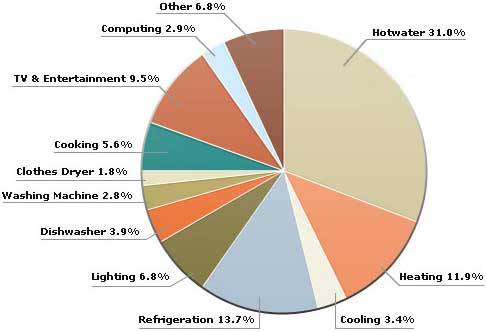Where does your power go? This chart from the NSW government Save Power website shows you the power consumption of a typical home in Sydney. It will give you a basic idea on typical power usage and where you can start to make some savings.

Eight top tips to save power
- Use appliances in off peak times: Your clothes dryer, washing machine, dishwasher are used on most if not all days and together accounts for almost 10% of energy usage. These appliances can be used at the off peak times with a little behavior change costing you 10 cents per kilowatt rather than 44 cents.
- Dont keep old appliances: The typical home has multiple televisions, one new plasma and one or more older sets. If purchasing new items maybe sell or giveaway the others so you don’t end up with 3 or more televisions in the house and two fridges in the garage. Do you really need that many?
- Switch off lights when you are not using them:The typical home still has incandescent light globes. However a single light is usually replaced with multiple down lights which can actually lead to higher power consumption. We estimate that modern lighting could account for 10% of your power bill. Learning to switch them off when not in use especially in the peak 2pm to 8 pm time slot will make a difference.
- Turn appliances off at the power point: Did you know that 10% of your entire energy bill is generated by appliances in standby mode. Are there some big items like the television and entertainment systems that can be switched off easily at a single point when they are not being used? Maybe some appliances that are not used very often at all can be easily switched off at the power point.
- Set air conditioning temperatures: A typical home in NSW uses the most power in winter due heating. Heat and cool your home to realistic temperatures in each season. Generally the best temperature to set your air conditioning to is around 24 – 25°C in summer and 17 – 19°C in winter. You can save considerably on the amount of energy consumed for each 1°C of cooling or heating that you do without. Try and balance between comfort and efficiency of the system.
- Choose energy efficient appliances: Replace items in your house as they become older with more energy efficient items. Concentrate on the major appliances that you use everyday that make up a considerable part of your bill. When purchasing major appliances pay attention to the energy rating and the actual size of the unit you are purchasing in relation to your needs. Bigger is NOT usually better in the power consumption department!
- Replace your electric hot water system: An electric hot water system will account for over 30% of your energy usage. A solar hot water system will supply 80% of your hot water free from the sun and depending on the family and their water usage, can save you up to $300 per year.
- Identify energy inefficient behavior – Is this you?
NSW Government Save Power department has highlighted inefficient behavior as the following:
- Heating / cooling: heats to “warm” 23°C in winter and cools to “cool” 20°C in summer
- Has no draught proofing, no curtains and does not close off the space being heated and cooled
- Uses heating and cooling quite often (more than just very hot days for cooling and very cold days for heating)
- Has a 2.5 star top-loading washing machine connected to hot water used daily
- Uses the electric clothes dryer after each wash
- Rarely switches off lights that are not in use
- Uses remotes to turn off TVs, entertainment equipment and computers
- Leaves most devices on at the power point
If you answered yes to all of the above look forward to the positives, with a little change you could enjoy a surprising saving on your next energy bill.

